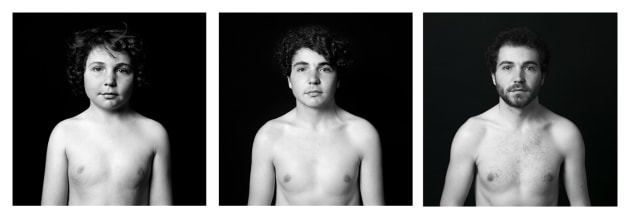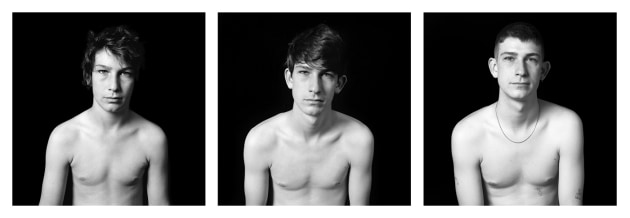Q&A: Ella Dreyfus on shooting the same subjects for 14 years
Ella Dreyfus is an artist and photographer, who has also been a lecturer in photography for 21 years at the National Art School.
Under Twenty-Seven is the third instalment in a series of photographic exhibitions featuring portraits depicting the same group of men as they evolve from childhood to adulthood – from boyhood in 2005, through adolescence in 2012, and into the young men they are today in 2019. The boys, all childhood friends of the artists son, are now 26. Her solo show Under Twenty-Seven is open 22 October – 03 November 2019 Bondi Pavilion Gallery, Bondi Beach, Sydney.

What inspired you to develop this work, and continue with the series?
I’ve always been a photographer whose work focusses on the body in a state of transition. I had done a series on the pregnant nude body, and one on the aging body, which I still think is my most powerful work. I always wanted to expose things that don’t usually come to the fore - I’ve always been curious to look at the ordinary, and dig deeper, to look and find things just below the surface.
I knew these boys from the soccer team, and they had all been friends since they were 6 years old. The first exhibition was when they were finishing primary school. At that age there’s an innocence, and I knew I wanted to capture this moment before the imminent loss of childhood – before they got to high school.
As a mother, artist, photographer, it was a way for me to retain that fierce love you have for children, and that sense of impending transition and change. They were on the cusp of something new.
As soon as I saw the images on the gallery wall, I made a note to myself, that I wanted to follow it up. I was patient and waited another 6 years to do the next series when they all finished high school. Two of the original boys didn’t do the second instalment, but this time around all of them returned.
I took the portraits over six months as it took me that long to track down all the young men and line up a time to make their portraits. Some were overseas, some interstate, and some still living in the same neighbourhood.

I understand that there was some controversy around the first set of images in the series, but how does the work sit in the context of the current political and social context – the role of gender and evolving masculinity?
The exhibition provides an opportunity for audiences to reflect on the representation of masculinity in contemporary culture, by showing them in a way that is distinct from the narrow ideals generally found in the mass media and advertising. The portraits explore the experiences of the young men, and the influence of social demands and perceptions of masculine attitudes, looks and behaviours.
There has been so much more discussion about the way we can and can’t photograph children since the first series. Child pornography and child abuse has exploded, and there is understandably a high sensitivity and care around children. I work with National Arts School and we talk about our responsibility to protect children and as an artists and photographers, all of us has a duty of care to protect children.
But at that time, after we shot the photographs two parents had concerns and wanted their sons removed from the exhibition. All the boys enjoyed it and we had all parental consents, but underneath it all was fear that their children would be in some danger. The photos were masked and it unintentionally became a provocative comment on censorship, which flared up around the Bill Henson censorship case.
It’s the job of art to be challenging. That’s why I’m an artist. The curiosity to look at the underbelly of humanity drives me to explore philosophies a bit deeper in the face of commercialisation and mainstream media. My Pregnancy series was successful because it revealed something people had never seen or been exposed to. We’d been so sanitised.
All my work before this had been women – I was very focussed on women's experiences and feminism and the image. Then when I had my son, who is now 26, I entered the world of male hood I didn’t know much about before.
In the current context, of masculinity and femininity, we know it’s so challenging for young men and women to grow into adults. That's the culture that were in, and my work speaks to that today. Beautiful children becoming beautiful men. It’s a joy these men have all come so far, and you just hope that continues.

What does the work say about the subjects themselves?
There is a difference when you know the subject and when you don’t know them. You can take a magnificent shot of a stranger or a lousy shot of your wife, but I will argue that there is something special when you know people, they relax more in your presence and you get a fabulous shot.
I believe the combination of my technical skills with the equipment but also my interpersonal skills and relationship with my subjects makes me the kind of photographer that I am. The rapport that I develop with my subjects leads them to show something of themselves to me. When I select, edit, print, crop and get the final image on the wall – I’ve chosen the one that speaks to me that has authenticity and a point of connection.
They’re looking at me – they know me as the mother of their friend, I've known most of them since they were children but hadn’t seen them for years. It was a joy to see them and they were happy to see me.

How do you want the photographs & the exhibition make people feel?
The audience will bring themselves, their biases, the way they view the world to any exhibition, and these images propel viewers back into their childhood and parenthood, it brings up huge emotions for people to witness the passing of time, the progression from childhood, through adolescence into early manhood.
It’s important to me what happen when an image gets released into the public space – it’s not just a photograph, it’s about what happens to the viewer when they enter a hallowed space. Galleries are like churches, a place where ideas can percolate, and people have the space to think and feel. That’s what I want. I want to communicate ideas, and people to feel safe enough to experience their own feelings.
My whole career has built on intimate relationships between me as the artist, the subject and the viewer. My PHD was titled ‘Shame and the Aesthetics of Intimacy’ – and I was looking to uncover complex and difficult things, and experience something intimate.

Why did you choose black and white for these images?
In a lot of my work I walked along a very fine line that could fall one side into beauty and one side into ugliness and this harks back to this tradition of black and white. With the pregnancy series, the subject matter was confronting and challenging for people – it was push and pull. Black and White lures people in, people find comfort in the softness of black and white to the discomfort of the subject matter.
What camera kit do you use?
The Under Twenty-Seven portraits were shot in two different photographic studios, at my home studio and in the photomedia department at the National Art School where I work as a lecturer in photography.
In the first series, Under Twelve in 2005 I used my Hasselblad 503CW camera with an 80mm lens and Agfa APX 100 ISO 120mm black and white film. They were printed using Agfa fibre-based photographic paper that requires air drying and flattening out with a dry mounting press.
I processed the film and made the contact sheets myself. In those days of analogue printing I liked to edit and select the negatives for printing with a special process. I spent hours looking through a magnifying glass at the details, then spreading them all out on a table and moving them around to select the best images for the series. Editing can make or break the mood and tone of the work and I worked carefully to choose body and facial expressions on the boys that would suit each other.
For the second series Under Twelve Under Twenty I repeated the processes, taking the new portraits with the same studio, camera, film processing and editing techniques. By then digital printing had really improved and I was keen to try it, so I worked closely with Pixel Perfect, in Sydney, and they were printed on a beautiful rag paper.
For Under Twenty Seven, the third series in 2019 I made the full conversion to digital processes with the Hasselblad H3D camera with 80mm lens, and ink jet prints on rag paper. I worked with Master Printer Richard Crampton from Darkstar Digital in Sydney. Richard suggested UltraChrome pigment inks on Canson Photographique paper. It was a great choice and when you see the prints in the flesh you'll see why. The blacks are deep and velvety and the skin tones are smooth and sensuous.
I still miss moving the small paper prints around a table, comparing each shot to the other and building a series. It's not the same on a screen but the fine detail is just phenomenal in digital.

Was it challenging to build the series over so many years so that all the images complemented the previous two exhibitions?
It was, particularly as the young men had grown so much compared to the earlier series, and I needed the three images to work as a group. It's amazing how subtly different 30 photographs of the same person at the same time can be. I had to peer into every aspect of every portrait to select the image that not only fits with the previous ones, but gives makes an emotional impact.

How did you get into photography & what does photography mean to you – what makes it powerful or valuable?
I grew up in house that was always making things – My mother was a ceramicist, she was always making things – and I was lucky to grow up in an artistic environment where I was supported to follow artistic desires. I got interested in photography and I love the power of the camera to give us the detail of people’s life – and reflect back on who we are.
What were your influences as a photographer and for this series?
Michael Apted’s UK TV series Seven Up was hugely inspirational. Also Nicolas Nixon’s 40 year long series The Brown Sisters, where he has taken a photograph of the four sisters every year is fabulous. So this idea of a series isn’t exactly original – but it’s specific.

Is this the last we’ll see of the boys in the series?
I've already announced to the men that they'll be hearing from me every seven years and we'll continue the cycle for a total of seven times! I’ve done the maths and I’ll be in 80s and they will be 53. Even if someone else has to hold the camera, I’d like to do it.
More info
UNDER TWENTY-SEVEN by Ella Dreyfus
22 October - 03 November 2019
Bondi Pavilion Gallery, Bondi, SYDNEY. Free admission to gallery & all events.
OPENING NIGHT Wed 23 October 6-8pm. Guest Speakers & Music performance
ARTIST TALK with Dr Ella Dreyfus. Sun 27 Oct 3-4pm
PANEL DISCUSSION Picturing Masculinity (with Guests Photographer Paul McDonald & Prof of Media Catherine Lumby). Sun 03 Nov 3-4pm


